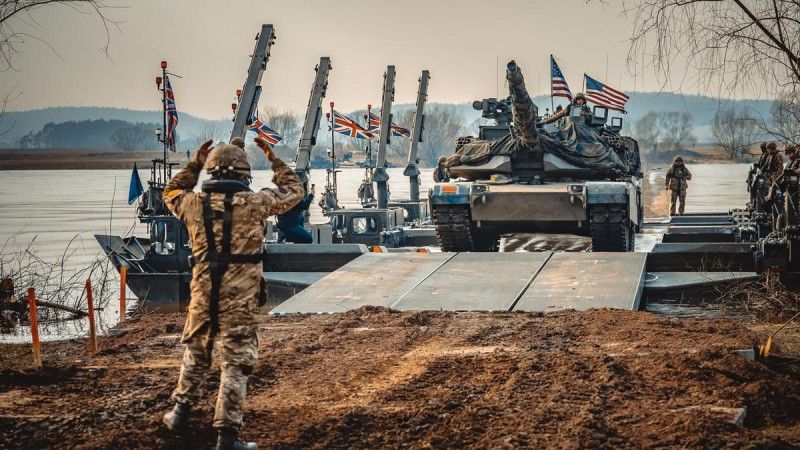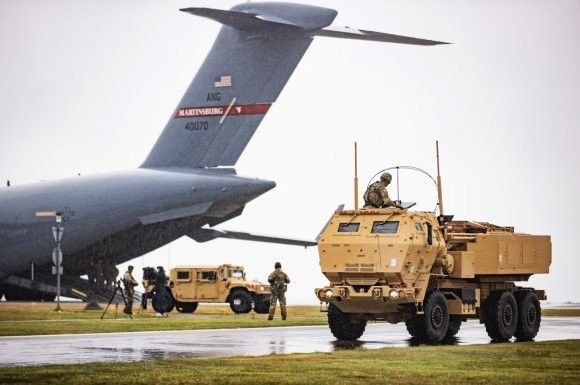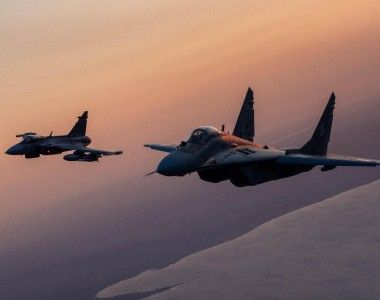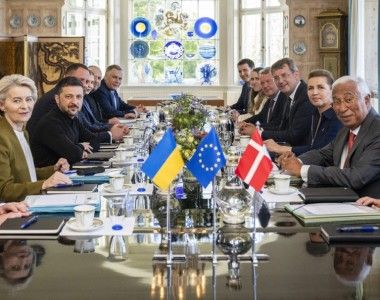Strike, Sustain, Survive. V Corps in the defence of Poland and Europe [INTERVIEW]

Photo. kpr. Sławomir Kozioł
Defence24 had an opportunity to take an interview with Colonel Brian T. Hoffman, from the V Corps US Army. Jacek Raubo asked Colonel about the various questions dedicated to lessons learned from the present functioning of the US Army on the NATO Eastern Flank and, of course, in Poland. Therefore, we can hear why we need to realize that in a future conflict, we may not have the luxury we had a decade or century ago just to own the battle space.
Jacek Raubo, PhD (Defence24): Colonel, first, thank you again for giving this time to the Defence24 readers. I want to ask you about the role of the V Corps (US Army) in the larger context of NATO and the Eastern Flank. How do you see the V Corps modernization due to the new challenges here on the Eastern flank and in this so-called global competition between the modern powers?
U.S. Army Colonel Brian Hoffman (V Corps): Well, Dr. Raubo, thank you so much for the opportunity. I really appreciate being able to sit down with you and have this discussion. Thank you for your interest in not only Polish defense security but also Poland’s allies and partners like the US, and our commitment to your national security as well as to NATO sovereignty. So, for V Corps, why we’re here: We offer a unique capability to the US and to NATO which is that we are the US Army’s only forward-deployed corps.
As you know, we are sitting here in Camp Kościuszko, where we have a forward presence with the main headquarters back at Fort Knox, Kentucky. We also have regionally aligned forces along the Eastern Flank of NATO, and some assigned forces that are in Germany.
Read more
We take our mission very seriously, which is to assure, deter, and defeat aggression focused on NATO. We’re focused on adversaries who are interested in creating problems and friction for NATO and those who might even be interested in taking some of NATO’s sovereign territory. We are here to assure our NATO partners, to create deterrence, and make (aggression) a more difficult decision on the part of our adversaries and then, when called upon, to respond rapidly to prevent and address any threats facing NATO.

Right now, we sit as a US formation operating under US Army European Command, and underneath them is the Headquarters of US Army Europe-Africa. We work for US leadership and US organizations, but we are charged with, tasked with, and given the responsibility to not only build US combat credible forces, taking units coming from the US and taking our assigned formations in Germany, but turning those into combat credible forces ready to rapidly transition to crisis and conflict when called upon.

Photo. Jacek Raubo/Defence24.pl
We also build similar capability and capacity with our partners and allies. I really want to emphasize „similar”. The US model doesn’t have to be the version our partners and allies« use. But we demonstrate for them all our experience with warfighting, our experience training at it, and how it works for our formations. Then they can choose to integrate some aspects of that. This can be with platforms, and in the case of Poland, they have done this with HIMARS, the Abrams, and the Apache. But also doctrinally, in terms of material and how to integrate those systems.
Read more
So, back to your question. It’s about assuring, deterring, and defending the European, Euro-Atlantic area within which we are building a combat credible force with US formations under US authorities and working closely with partners from Estonia to Bulgaria to make sure we collectively, as NATO formations, can execute this mission to assure, deter, and defeat our adversaries.

Photo. Jacek Raubo, Defence24
And then, finally, we work with our partners and allies, on a daily basis, not only because we’re assigned that task but because we also recognize that if and when we transition into a conflict, we may likely work underneath NATO formations. So, we may have the Polish II Corps next to us as an adjacent unit to the V Corps. We may have Polish formations inside of V Corps. We may have US formations underneath the Polish II Corps. So, it’s critical that we understand how our adjacent formations operate, think, and behave because we’re going to all be part of this team together to really defend Europe. And that’s why it’s so important to us to have these relationships.
Jacek Raubo, PhD (Defence24): Colonel, we are approximately two years after Russia’s full-scale invasion of Ukraine. Therefore, we know very well that full-scale warfare is returning to Europe as a practical military issue. So, can you give us examples of how the V Corps is taking these lessons learned from this fragile situation?
U.S. Army Colonel Brian Hoffman (V Corps): I appreciate the question. In preparation for the interview, I was looking at some of the key things to share that we are not only taking seriously but looking at how to apply resources towards and integrate. And so, I’ll offer you three for that. The first one is long-range precision fires. The second one is going to be survivability. And the third is going to be contested logistics. And so, there are a lot of lessons that were learned which are coming out of the Ukraine. But those are three the corps has taken very seriously.
Read more
It’s about our ability to project fires very deep in the fight, whether it’s artillery or rocket platforms. We are integrating those formations, that capability, into everything we do. This way we can project that force forward against the enemy and have an ability for deep strike, and that’s not only at the V Corps level because there are also higher echelons that are looking at the ability to strike very deep.

Photo. U.S. Army Pfc. Aiden O'Marra, domena publiczna
But tied to that is our ability to survive such strikes. So, we’re integrating what it means to survive the modern battlefield, and the future battlefield. It may be small unit formations in dispersed areas…but it also includes headquarters. What we have done for decades is have very large headquarters spread out among many tents or even in a big complex with a lot of antennas, because we were outside of artillery range, and even outside of many rocket artillery ranges. It was not a threat to us. Well, now through cyberspace and enemy deep fires we no longer have that luxury. So, we’re learning from the Ukraine conflict, from our experiences in exercises and training, how to survive a conflict, and doing this from the squad and platoon level all the way up to the corps headquarters level.
And I’ll be frank, it’s not easy. We’re really having to reinvent how we survive on the modern battlefield. And our distance from the front line, in some ways, is not as important. Our ability to understand where we can be struck by the enemy, kinetically or not kinetically, is really driving how we do this.
Read more
And then the third piece is the logistics. We realize and acknowledge, in ways that we’ve never seen before, that logistics will be contested. Again, through cyber and space but also through kinetic means by the enemy. Just getting things from the US over to Europe is a big focus of European Command and US Army Europe-Africa. Within V Corps, we’re focused on - from the port to V Corps, how are we getting things here? And are we doing it in a timely matter, and setting conditions to avoid the enemy’s ability to attrit the logistic capability being pushed forward?
And that’s a big focus of ours right now. We’re looking at what ports are available in Central Europe. How do we access those ports? How do we rehearse that now, so we’re not waiting until conflict to do that? How do we rehearse getting things moved across Europe? And Europe presents its own challenges because in many cases, it’s not only that roads are narrow and the highways are narrow, in the event of a crisis these roads are going to be congested. So, how do we move things with a limited number of aircraft?

Photo. Army Capt. Angelo Mejia
And so again, it’s about what we do with long-range fires and how we protect ourselves from those long-range fires and other non-kinetic adversarial means. And then, thirdly, what we are doing to ensure we have logistics on time and in the right place.
Jacek Raubo, PhD (Defence24): Colonel, you often mention the logistic factor. Due to this, I want to ask you: Do you see any developments in Poland and other states you mention regarding the host nation’s role when you’re working with the NATO partners?
U.S. Army Colonel Brian Hoffman (V Corps): That’s a great point that we’re still discovering and learning. What we’re committed to is when we do exercises, to put effort in prior to the exercise-start to conduct these (logistical) events. During the execise we are also integrating the host nation at a couple of levels.
So, we acknowledge and realize that in a future conflict, we may not have the luxury we had a decade or century ago to just to own the battle space. To just say „move out of the way”. Even in friendly territory, „move out of the way, and we will do what we need to do to reach our objectives and mission”. We acknowledge that the host nation’s interest will always be at the forefront of what we do.
Read more
So, how do we practice that now? How do we recognize national sovereignty? How do we do that under a NATO structure? And that’s something we’re focused on doing; understanding those laws, understanding how we can work within those laws. But also developing relationships, so that when we do transition to conflict we know who to call to say, „Can we make adjustments to your standards to allow us to do something we need to, given the risk and threat to your communities?”
But knowing who to talk to, knowing who to ask, and knowing what to ask is what we’re really learning.
The other piece, for host nation capability, that is an untapped resource are the Territorial Defense Forces (TDFs). From Estonia to Bulgaria, there are TDFs in almost every country. Now, they are employed in different ways, and their command structure is different in every country. But we see that as a significant combat capability and combat multiplier across the battlefield.

Photo. Sgt. Cecil Elliott II, domena publiczna
It’s about understanding the mission within each country of the TDFs and understanding how we can integrate with them. We don’t want to pull them into our formation but capitalize on the fact that in each of these countries, there are thousands of human sensors on the ground. How do we connect with them through digital means? How do we use the right command authority to ask for them to look at things on our behalf to be sensors? How do we get feedback from them in real-time?
That is why we are now focused on the Territorial defense piece. I will offer that in Poland, we’ve made yeoman’s work on understanding where you’ve got these forces laid all over Poland, but especially on the Eastern flank.
Read more
How do we tap into that capability within their mission, their resourcing, and your laws? How do we tap into that? And we’ve been doing this for years in the Special Operations community, but for us in the conventional force, we don’t want to wait till crisis or conflict to figure this out. And so, I think those are really two big pieces that have to do with host nations; understanding what we can do and should do with the host nation as our partners, and then this capability of the TDFs - How do we make one look like a hundred?
We »ve done a TDF symposium and plan to do more. We look at a region of Europe, even within Eastern Europe or, as you say, Central Europe. We sit down with those territorial defense leaders and we learn their mission, their resources, their capability, and we look at how we can integrate them.

Photo. U.S. Army Pfc. Aiden O'Marra, domena publiczna
So, we’ve done a TDF symposium already in Olsztyn, Poland. The Polish partners are wonderful hosts. And we invited about ten countries. We’re going to do another one coming up here. I believe it’s in Kraków later this year and then we’ll probably do one next year down in what we call AO Victory South, down in the Romania, Bulgaria area. But that’s where we are really bringing in these teammates that historically, we have not integrated.
Read more
We’re really aggressive with this to include our exercises. We did a warfighter in March that uses a simulation software system. We had never used the TDF and did not have what we call „pucksters.” We had no human being sitting at a computer „pucking” or moving a TDF. They could be in the system, but they were all, as we call them, „white cards”. We then created a situation where we had humans behind computers who were getting task and purpose and then executing them as the TDF. We tested this in a simulation, and it had significant combat capability and was detrimental to the adversary when we employed the TDF. So, we’ve got a lot to learn.
Jacek Raubo, PhD (Defence24): Colonel, I want to ask you your opinion of the Polish role in this cooperation with the V Corps and the US armed forces on the NATO Easter Flank and, of course, about Poznań as a location of the V Corps forward HQ.
U.S. Army Colonel Brian Hoffman (V Corps): I’m not privy to how those decisions were made that determined Poznan, Poland as the place for Camp Kosciuszko. What I will offer is that it puts us in the right place. I’m going to be frank with you: us being this far west allows Poles to be the face in the east of Poland. Poles are in the East, that’s where the dominant force is. We’re back a little bit to enable, reinforce, support, and work with (partners). So, I think strategically it gives us the time and space where we need to be, while giving deference to our Polish partners and Polish formations and leaders.
The town of Poznań is just phenomenal. I mean, we honestly love being here. We have many Soldiers who live off base in the community and are truly part of the community now, and so it’s been a wonderful opportunity for us here in Poznań.
Read more
But by putting a HQ here, we are demonstrating that we can organize resources and fight as a collective, combat credible force. Collectively as a corps, we’ve got a headquarters forward that can operate and fight from a command post that’s in Western Poland. And so, I think in summary, your question, why here? - Operationally, it puts us where we need to be to demonstrate combat credible forces…to be close enough to our partners and allies to rapidly access them.

Photo. U.S. Army Capt. Michael Mastrangelo, domena publiczna
It’s also great to host events here. We just had a counter UAS EUCOM-led symposium, and that allowed us to bring all our teammates together, forward. We’re not having to go back to the United States and not having to go back to Germany, and it really gives us an opportunity to be where we need to be.
Jacek Raubo, PhD (Defence24): Colonel, you have mentioned UAVs symposium; therefore, I want you to ask about the UAVs factor on the modern battlefield. Of course, simultaneously as a threat for allied forces, but also as a potential support for own troops.
U.S. Army Colonel Brian Hoffman (V Corps): We are taking two avenues of approach on this. How are we employing small UAS systems, medium-sized and large UAS systems? The US government and military have a lot of experience with larger platforms. There is a lot to be learned and shared with our partners and allies, but we see the fight involving a lot of UAS of various sizes and various means. Whether it’s air-breathing, through fossil fuels, or whether it’s battery-powered. How do we employ those as sensors, how do we employ them as a lethal capability? There’s a lot of work being done not only by the US Army and by the Department of Defense (DoD) in the United States. We here are also using our formations like the 2nd Cavalry Regiment, which has been tasked and given the mission to develop how we employ those small UAS systems for the US Army, and they’re doing a lot of amazing work.
The other avenue is the counter UAS piece. We have a lot to learn in the competition phase about counter UAS, like under whose authority can we use the Counter UAS system? So, even before we get to a conflict, like if we see a threat right now, whose authority allows us to employ a non-lethal or lethal system to target that UAS system?
Read more
Similar to our host nation relationships regarding logistical movements, we’re also working with our host nations and local police and authorities (about counter UAS). If we see a threat on one of our Forward Operating Sites (FOS): Who do we call? Who has the authority to respond? When can we then take action? And so that’s something we are doing FOS by FOS, and capability by capability.

Photo. U.S. Army photo by Spc. Devin Klecan, domena publiczna
It’s also about the (specific) UAS system. What’s the manufacturer’s origin? And if it’s a DJI (Dà-Jiāng Innovations), is that location in the DJI database to not be flown over, acknowledging someone can hack it and change it? So there’s a lot of complexities here. We see that translating to the transition from crisis to conflict.
Just because we’re in Poland, even in a conflict, and we see a UAS, it doesn’t mean we are going to necessarily be free to target it, by lethal or non-lethal means. Understanding how those local authorities transition during a conflict is crucial. So, not only are we developing the material solutions, but we are developing policy and doctrinal solutions on how you employ counter-UAS systems. I will offer that it’s very complicated.
Jacek Raubo, PhD (Defence24): Colonel, now I would like to ask about the impact of modernization processes in the Polish Armed Forces (purchase of MBT Abrams, acquisition of HIMARS systems, etc.) on interoperability with the US Army. How do technological changes help and increase cooperation between the land forces of both countries and maybe a wider picture of Eastern Flank cooperation?
U.S. Army Colonel Brian Hoffman (V Corps): First, let me speak outside of Poland. We have many partners looking at American platforms. Several of the nations are looking at HIMARS. Romania has publicly committed to buying, I think, 54 Abrams tanks. So, there’s a lot of opportunity there to put capability in these adjacent formations in our allied nations. How do we enable that? We’ve demonstrated our ability to do that through our relationships in Poland.
So, as you know, for foreign military sales, typically that comes with a training package that the US military program manager enables. That training typically focuses on the individual level.
Read more
Where we come in, and what we have been tasked to do, is to ensure our Polish partners at the collective level - at the squad, the platoon, the company level - can employ the systems on the battlefield. And how do formations at the battalion and brigade level, maneuver those smaller elements? All of that is where the „Abrams Academy” comes in.
We are focused on two approaches to this. Putting US soldiers in the formations with our Polish partners to help them work through doctrine and material solutions to employing the tanks. And then putting Polish soldiers in our formations. And we’ve had a lot of success with that not only at the Polish Academy (so-called Abrams Academy, close to Poznań, on the north outskirts of the city -JR) just north of here, but at our formations across Poland.

Photo. 18 Dywizja Zmechanizowana (@Zelazna_Dywizja)/X
The last statistic, was over the last 18 months or so, we’ve trained over a thousand Polish tankers on the Abrams tank. Putting them in the Abrams tank, hands on, on the range, firing the weapon systems, learning how to defend themselves, learning how to counter threats. And we’re seeing a direct correlation between doing that and then the fielding of the M1A1s to our Polish partners. The fielding, then putting those Polish (soldiers) on the range in their own tanks and firing, it’s quantifiably a significant leap forward.
We’re taking advantage of this task to build combat credible forces by putting them in our tanks, and we’re going in their tanks, and we are capitalizing on this.
Then we’re doing the same thing with a HIMARS. Our HIMARS initiative is focused on the strategic level to the tactical level. So, we sit down and do initiatives with them where we talk about, when and how would you employ HIMARS? How do you sustain the HIMARS? Down to putting Polish soldiers inside of US HIMARS so they understand how to fire and maintain those systems.
Read more
We only have so much capacity and capability here. So, we are making some very deliberate decisions on where we apply that. I can tell you quantifiably, we have seen significant gains with our partners by putting both of us together in these platforms as they get fielded to the Polish.
Jacek Raubo, PhD (Defence24): Finally, I want to ask you about the main security and defense challenges we will address in a short perspective, of course, based on your professional assessment.
U.S. Army Colonel Brian Hoffman (V Corps): I will offer three challenges that we’re focused on. The first one is back to our host nations. I talked about this. But let me bring together my previous comments from the last half an hour. It’s about understanding where and how we work with our host nations. It’s about using our civil affairs teams and our command-level relationships.
So, not only should we be able to effectively operate in a competition phase, but when we do the transition, we need to know who to talk to. We need to know, I’m going to be frank with you, what laws we have to follow, and if we are in a conflict and need to ask to have something adjusted, we need to know what to ask.

Photo. U.S. Army Spc. Bernabe Lopez III, domena publiczna
There will be some additional authority granted to military formations if we transition to a conflict, but it doesn’t give us carte blanche to just do whatever we want. So, we’ve got to learn what the laws are, and we’ve got to learn to ask if we need to make adjustments to enable defense of NATO sovereign territory. So that’s a challenge we have because, for us, it’s across eight nations on the flank, and we have to understand what those laws are across eight nations and who the right people are to talk to. We need to make sure we have those relationships.
Read more
It is complicated by the fact that we do nine-month rotations. Similar to what we experienced previously in the Global War on Terrorism (GwoT). We are on a cycle here. And so, how do you build those relationships and sustain those relationships? And that’s where V Corps comes in because we’re going to be forward and we’re going to stay forward. So when they (partners) see a RAF (Regionally Aligned Force) formation that is here for nine months, we are the connective tissue with the next RAF formation. That’s why it’s not just a task for two divisions and their brigades. We are integrated as a Corps staff into meetings and opportunities because we’re that continuity.
The second thing I would offer, is about the term we use - „interoperability”. We are challenged to sustain our technical means to communicate. So, we are really good at relationships. I truly believe we’re good at building and maintaining relationships and having a shared understanding of what our threats are. But how do we ensure that our Commanding General can pick up the phone and call any other adjacent formation or down-trace formation from another nation in a matter of seconds?

Photo. U.S. Army Capt. Gabrielle Hildebrand, domena publiczna
We can spend time building that digital connective tissue, but if we don’t keep doing it routinely, we will fall out of timing, and the connective tissue will come apart. So, interoperability is not something we can do episodically. It is something we have to focus on every day of every week, across all of the Eastern Flank, and that’s one of our biggest challenges.
Read more
Then let me throw you another challenge. If we transition to NATO, how do we integrate?
And so those are some of our biggest challenges; ensuring we understand and resource the connective tissue we have with our partners and allies…and understanding how to integrate as a NATO formation.
We are prepared to transition to conflict. We are there. But there is a lot of work that remains to be done to counter this enduring threat.
Jacek Raubo, PhD (Defence24): Thank you, Sir, for this interview.
Colonel Brian T. Hoffman, V Corps Prior to assuming command of Dugway Proving Ground, he served with the Fort Bragg, North Carolina Joint Special Operations Command’s (JSOC), specializing in Countering Weapons of Mass Destruction. Past operational assignments include the Fort Bragg, NC U.S. Army Forces Command, U.S. Army Reserve Command, the 82nd Airborne Division, and the 1st Special Forces Operational Detachment-Delta (Delta Force); the Fort Benning, Georgia 75th Ranger Regiment; the Aberdeen Proving Ground, Maryland U.S. Army Research, Development and Engineering Command, 20th Chemical, Biological, Radiological, Nuclear, and High-Yield Explosive Command, and the 22nd Chemical Battalion; and the Shaw Air Force Base U.S. Army Central Command. COL Hoffman has commanded Army elements at the rank of captain, lieutenant colonel, and colonel. Overseas assignments involve 12 deployments to Afghanistan, Iraq, Pakistan, and Syria. COL Hoffman’s most recent deployment includes service as the Deputy Director, then Director Commander’s Initiative Group, Combined Joint Task Force – Operation INHERENT RESOLVE.
















